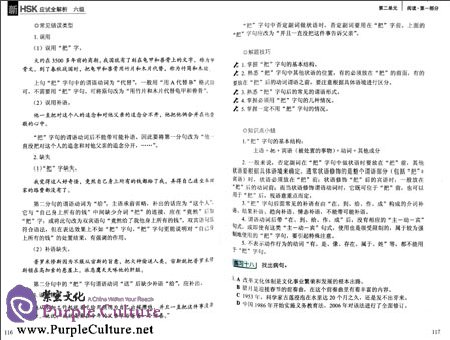Usage Advice: For self-study or tutorial programs
Level: Advanced
New HSK Analysis is a series of textbooks written for New HSK examinees. The series, consisting of five books, namely New HSK Analysis for Levels One and Two, New HSK Analysis for Level Three,New HSK Analysis for Level Four,New HSK Analysis for Level Five, and New HSK Analysis for Level Six, emphasizes both explanations and practice. The compilation style of the books is consistent, with the modules designed in accordance with the New HSK content. Each module is divided into several different parts, including Explanation of Question Types, Problem-Solving Skills, Important Testing Points, Past Test Analysis, and Practice of Specific Language Skills. Moreover, the series has three or four sets of mock tests in the end in order for readers to test themselves. All the exercises and mock tests have Q & A explanations for the convenience of students’ self-learning and teachers’ instructions.
The series of New HSK Analysis, based on a thorough investigation into the examination syllabus and the past examination papers, summarizes the language points, and analyzes the types of questions. It focuses on the recurrence of high-frequency words, without neglecting words not listed in the examination syllabus. The combination of training and testing improves not only candidates’ language proficiency, but also their test-taking skills.
Designed for examinees of HSK (Level 6), New HSK Analysis (Level 6) summarizes 16 testing points in the listening comprehension part and over 40 testing points in the reading comprehension part. It explains and practices in great detail the methods of condensing from the sentences to the passages. Each question is provided with an example for the condensation. There are abundant exercises in the book, including 58 exercises for specific skills and three sets of mock tests. An MP3 CD with the recordings for the listening comprehension exercises and the mock test are attached to the book.
About the Author
The Editor-in-Chief Wang Sumei has rich experience in TCFL (teaching Chinese as a foreign language), HSK guidance and textbook compilation. She is the chief writer and one of the major designers of the Simulated Tests of the New HSK (Level 6) published by Beijing Language and Culture University Press.

1.误用
(1)误用“把”字。
大约在3500多年前的商朝,我国就有了刻在龟甲和兽骨上的文字,称为甲骨文。到了春秋战国时,把龟甲和兽骨用竹片和木片代替,称为竹简和木牍。
上句“把”字句中的谓语动词为“代替”,一般用“用A代替8”格式即可,不需要用“把”字句。可将原句改为“用竹片和木片代替龟甲和兽骨”。
(2)误用补语。
他一直把对这个人的追念和对他父亲的追念分不开,他把他俩合并在他崇敬的心中。
“把”字句的谓语动词后不能带可能补语。因此要将第一分句改为“他一直没把对这个人的追念和对他父亲的追念分开,……”。
2.缺失
(1)“把”字缺失。
我觉得这人好奇怪,竟然自己身上所有的钱都给了我,弄得自己连坐车回家的路费都没有了。
第二分句的谓语动词为“给”,主语承前省略,补出的话应为“这个人”,它与“自己身上所有的钱”中间缺少介词“把”的连接,应在“竟然后加“把”字;或将此句改为双宾语句“竟然给了我他身上所有的钱”。双宾语句虽符合语法,但在表达效果上不如“把”字句。“把”字句更能说明对“自己身上所有的钱”的处置结果,有强调的作用。"